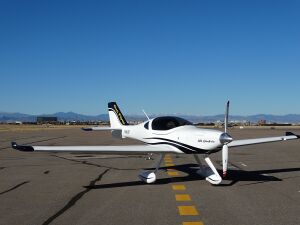Engineering:Bye Aerospace Sun Flyer 2
| Sun Flyer 2 | |
|---|---|

| |
| Role | Electric training aircraft |
| National origin | United States |
| Manufacturer | Bye Aerospace |
| First flight | 10 April 2018 |
| Status | Under development (2018) |
| Number built | 1 |
| Variants | Bye Aerospace Sun Flyer 4 |
The Bye Aerospace Sun Flyer 2 is an United States electric light aircraft designed and under development by Bye Aerospace of Denver, Colorado. The design was originally developed by Bye Aerospace subsidiary, the Aero Electric Aircraft Corporation, but the two companies merged in 2018 and Bye Aerospace took over the project.[1][2][3]
The Sun Flyer 2 was first publicly introduced at the Centennial Airport in Colorado on 11 May 2016 and it first flew on 10 April 2018. The aircraft is intended to be certified under FAR 23 and supplied as a complete ready-to-fly-aircraft.[1][2][3][4][5]
Design and development
The aircraft has been designed specifically for the flight training market and will have a 3.5 hour duration.[1][2] Arion Aircraft of Shelbyville, Tennessee constructed the proof-of-concept prototype and delivered it in March 2016.[6][7]
The Sun Flyer 2 features a cantilever low-wing, a two-seats-in-side-by-side configuration enclosed open cockpit under a bubble canopy, fixed tricycle landing gear and a single Siemens SP70D electric motor in tractor configuration, powered by up to six Lithium-ion battery packs.[1][2][6][8][9]
The aircraft is made from composite material, primarily carbon fibre. The cockpit employs an iPad used for cockpit instrumentation display, including motor, battery and aircraft systems. The aircraft connects to Redbird Flight Simulations' Sidekick system, which wirelessly tracks the Sun Flyer's engine, flight time, physical location and attitude in real time when in flight.[1][6]
The aircraft has a gross weight of 1,900 lb (860 kg).[1] The take-off noise profile is expected to be lower than conventional piston-engine powered training aircraft, such as the Cessna 172.[8][10]
Ground and taxi tests on the prototype were started in November 2016 and the aircraft first flew on 10 April 2018.[4][5][11]
A four-seater derivative model, named the Bye Aerospace Sun Flyer 4, was later announced in July 2017. It will be a day/night IFR aircraft with an 800-pound payload, capable of 150-knot maximum cruise speed and a 4.2 hour endurance.[8][12][13]
Development of the four-seater should follow completion of the smaller Sun Flyer 2 through certification for $25 million, Bye received 220 orders for the two models by October 2018. For Bye, conventional aircraft with electric power can be used today, contrasting with futuristic electrical VTOL aircraft, using existing infrastructure for flight training, air taxi service and small package delivery. For flight training, energy costs $3 per hour compared to $45-50 in a conventional avgas trainer.[14]
Operational history
By March 2018 one example, the prototype, had been registered in the United States with the Federal Aviation Administration.[15]
By March 2018 the company had 105 deposits for the Sun Flyer 2 and 16 deposits for the larger Sun Flyer 4.[3]
Operators
The following organizations have ordered the aircraft:
Specifications (Sun Flyer 2)
Data from AVweb and manufacturer[1][8]
General characteristics
- Crew: one
- Capacity: one passenger
- Wingspan: 38 ft (12 m)
- Wing area: 129 sq ft (12.0 m2)
- Empty weight: 1,460 lb (662 kg)
- Gross weight: 1,900 lb (862 kg)
- Powerplant: 1 × Siemens SP70D[16] electric motor with up to six lithium-ion battery packs, 115 hp (90 kW)
- Propellers: 2-bladed composite
Performance
- Maximum speed: 135 kn (155 mph, 250 km/h)
- Endurance: 3.5 hours
- Maximum glide ratio: 20.6:1
- Rate of climb: 1,050 ft/min (5.3 m/s)
See also
Aircraft of comparable role, configuration and era
- Pipistrel Alpha Electro
- Liaoning Ruixiang RX1E
- Yuneec International E430
Related lists
References
- ↑ 1.0 1.1 1.2 1.3 1.4 1.5 1.6 "Sun Flyer Promises Three-Hour Flight Time". avweb.com. http://www.avweb.com/avwebflash/news/Sun-Flyer-Promises-Three-Hour-Flight-Time-224539-1.html. Retrieved 13 May 2016.
- ↑ 2.0 2.1 2.2 2.3 2.4 "Sun Flyer Proof-Of-Concept Model Rolls Out". avweb.com. http://www.avweb.com/avwebflash/news/Sun-Flyer-Proof-Of-Concept-Model-Rolls-Out-226225-1.html. Retrieved 13 May 2016.
- ↑ 3.0 3.1 3.2 Bye Aerospace. "Projects". https://www.byeaerospace.com/projects/. Retrieved 20 March 2018.
- ↑ 4.0 4.1 Bye Aerospace (11 April 2018). "Bye Aerospace Announces First Flight of Sun Flyer 2". sunflyer.com. http://sunflyer.com/2018/04/11/bye-aerospace-announces-first-flight-of-sun-flyer-2/. Retrieved 11 April 2018.
- ↑ 5.0 5.1 Grady, Mary (11 April 2018). "First Flight For Sun Flyer 2". AVweb. https://www.avweb.com/avwebflash/news/First-Flight-For-Sun-Flyer-2226128168226128168-230637-1.html. Retrieved 15 April 2018.
- ↑ 6.0 6.1 6.2 "Sun Flyer Prototype Readying For Final Tests". avweb.com. http://www.avweb.com/avwebflash/news/Sun-Flyer-Prototype-Readying-For-Final-Tests-225789-1.html. Retrieved 13 May 2016.
- ↑ "Sun Flyer Prototype On Assembly Line". avweb.com. http://www.avweb.com/avwebflash/news/Sun-Flyer-Prototype-On-Assembly-Line-224471-1.html. Retrieved 13 May 2016.
- ↑ 8.0 8.1 8.2 8.3 Bye Aerospace. "Specifications – Sun Flyer". http://sunflyer.com/specifications/. Retrieved 20 March 2018.
- ↑ Grady, Mary (29 May 2018). "Siemens Electric Motor Will Power Sun Flyer 2". AVweb. https://www.avweb.com/avwebflash/news/Siemens-Electric-Motor-Will-Power-Sun-Flyer-2-230896-1.html.
- ↑ "Sun Flyer by AEAC Aero Electric Aircraft Corporation". Sun Flyer by AEAC Aero Electric Aircraft Corporation. http://www.sunflyer.com/#!programs/mainPage. Retrieved 13 May 2016.
- ↑ Kauh, Elaine (17 November 2016). "Sun Flyer Begins Ground, Taxi Tests". AVweb. http://www.avweb.com/avwebflash/news/Sun-Flyer-Begins-Ground-Taxi-Tests-228049-1.html. Retrieved 18 November 2016.
- ↑ Huber, Mark (July 26, 2017). "Electric Sun Flyer Plans Fall First Flight". AIN Online. https://www.ainonline.com/aviation-news/general-aviation/2017-07-26/electric-sun-flyer-plans-fall-first-flight. Retrieved 2017-10-26.
- ↑ Cobb, Alyssa J. (July 24, 2017). "Four-Seat Sun Flyer in the Works". AOPA. https://www.aopa.org/news-and-media/all-news/2017/july/24/four-seat-sun-flyer-in-the-works. Retrieved 2017-10-26.
- ↑ Mark Huber (October 18, 2018). "Bye Pitches Electric Aircraft for Charter". AIN online. https://www.ainonline.com/aviation-news/business-aviation/2018-10-18/bye-pitches-electric-aircraft-charter.
- ↑ Federal Aviation Administration (20 March 2018). "N-Number Inquiry Results". http://registry.faa.gov/aircraftinquiry/NNum_Results.aspx?NNumbertxt=502SF. Retrieved 20 March 2018.
- ↑ Pope, Stephen. "Siemens Electric Motor Will Power Sun Flyer 2". Flying Magazine. https://www.flyingmag.com/siemens-electric-motor-will-power-sun-flyer-2. Retrieved 2018-05-29.
External links

